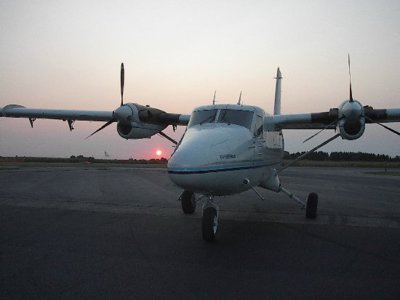Recommended Posts
But that increases cycles which adds other expenses. Of course, I'm all for running that ignition just as often as possible![]()
QuoteAnyone know the fuel burn of a PT-6
Do you want to know bad enough to still want to know tomorrow? I can ask
tdog 0
QuoteAlso, what does anyone think of some of these big 7-day a week operations maybe closing one or two days during the week to save in overhead?
If every dollar of revenue that would have been earned that day will be "earnable" on an open day (the customer can come on that day + there was open slots that can be filled) then maybe you can save some money.
A quick and dirty spreadsheet with fixed costs vs variable costs could be made.
There is a interesting theory about liquor stores that are open for 6 days a week (closed on Sunday). The theory is that people will buy the same amount of liquor per person. If you are open 6 days - your variable costs are 14.2% less than if you are open 7 days. Hence 14.2% more profit.
This theory only works with the assumption that:
1) Everyone knows liquor stores are open 6 days a week and purchase all their liquor on those 6 days in preparation for the days the stores are closed.
2) No one ever screws up and runs out of liquor on Sunday at a party....
Skydiving is different. People in vacation destinations only can jump when on vacation (tandems) and fun jumpers might have weekdays off not weekends...
I don't think the cost savings are worth it... If the DZ has enough people to fill the plane to justify the load, might as well open. It is not like an office building with tons of lighting and HVAC bills....
I think the #1 cost saving move for a DZ. LOADING TIME ON HOT TURNS.
Say a DZ can make $600 an otter load on fun jumper slots.... 1 minute of load time saved * 20 loads = 20 minutes a day. 20 minutes a day = 1 extra load. 1 extra load = $600 more gross revenue. Plus 20 minutes of fuel/engine time saved. Lets say that combined the DZ can make $300 more net profit by that extra load. That is $31,000 for a weekend only DZ per year. That is 6200 gallons of fuel the DZ is able to purchase. That is about 10% of the same DZ's yearly fuel needs.
Or.... $300 per day profit = $.65 per jumper/slot.
Next time the plane sits on the ground for a minute - think about the fact your jump ticket went up $.65. Two minutes = $1.20! It adds up!
Jet -A
Self ser. $4.37
Full Ser.$5.99
average $5.35 gallon
Kerosene K-1
2007 $2.86
lst wk $3.55
current $3.65 Per gallon
Factor in the off season and bulk rate 2.86 or less is a good guess for 3K gallons. Your local prices may vary.
Only good in the turbine fleet, not good in the 182's.
Q.-hey how come your 100LL marked tank has pink shit coming out of it? A- well at least it's not green.
lippy 918
Quote1) Everyone knows liquor stores are open 6 days a week and purchase all their liquor on those 6 days in preparation for the days the stores are closed.
That theory doesn't work for the pothead/alcoholic clientelle. Example:
Q-Dude, it's Sunday, did you buy beer?
A-Dude, it's Sunday????
Case and point
QuoteQuote1) Everyone knows liquor stores are open 6 days a week and purchase all their liquor on those 6 days in preparation for the days the stores are closed.
That theory doesn't work for the pothead/alcoholic clientelle. Example:
Q-Dude, it's Sunday, did you buy beer?
A-Dude, it's Sunday????
Case and point
True but their total consumption is not a function of time, it is a function of income.
QuoteEasy ones are for the plane not to start until everyone is inside and buckled in. That will save 3-5 minutes of fuel burn during every loading sequence if the plane shuts down. On a dozen loads a day that is the about 30-50 minutes worth of fuel burn that you can save.
Sorry Phree but that 3-5 minutes of warmup just might prevent an engine failure. If an engine is not allowed proper time to get fully warmed up even in the summer the stress of takeoff power can cause failure. We should be careful about what we suggest.
However, what people can do is get on, get buckled and set quickly so there is minimum time in between loads. That is where a lot of time can be wasted. People running to a plane idling on the ground no geared up can cost big money.
www.diverdriver.com
ATP/D-19012
FB #4125
Lawdog1 0
I always thought I was "cranking loads" when I was on the takeoff roll as my last tandem was about to touch down. It really doesn't get to be any better on turn times.
A HUGE fuel savings can come from having your pilots fly at best rate of climb religiously. Sloppy flying can cost lots of money. Pilots who do aerobatics to get on the ground faster are only stressing the plane more. What do they save? 30 seconds? 60 seconds? It's the climb. That's the key for the pilot.
Find the direction of an increasing headwind = free lift.
Thermals.
Hitting jumprun altitude as you are powering back and hitting the green light (applies only to turbines that don't shock cool doing that)
www.diverdriver.com
ATP/D-19012
FB #4125
QuoteA DZ in MI recently changed its practice to put the tandems out FIRST at 10k-11k on one pass and the up jumpers, and AFF out at 13.5-14k on a second pass with their standard engine caravan. This seems to save quite a bit of upper altitude climb time which in turn saves gas ( I Like), Reduces the possiblity of later groups getting out too far away and having to pull high (I also like) and the Tandem students don't seen to be complaining about losing 15 sec or so of free fall time.
I've heard that. What I'd like to know is if it really saves fuel? My speculation would be that it doesn't really save much fuel because the pilot has to level the airplane off at 10 to 11K, get on jumprun, put the Tandems out and then continue on to 13 or 14K for the rest of the up-jumpers. Continuing, I'd further sepculate that what it does do is keeps the Tandem Masters from bitching that they're getting hung out on a long spot and have to dump high because the jumpers going first or in between cannot spot or are taking too long in the door and/or the pilot isn't as adebt with GPS as he or she could be? One thing I guess I'd like about this formula is that with the Tandems back by the door and as an up jumper I'd be towards the front of the plane... 1) Warmer in winter... 2) I wouldn't be back in the back and have to listen to TMs bitching about extra space to hook up their passenger when getting near jump run... but that they say "is a different story!"
Anywho... having said all that though... if the DZ in question has run the numbers or by experiment has shown then they are saving fuel doing things this way... good on them!







Not to mention they won't have to turn on the heat or a/c or lights or have to pay to flush to toilets and restock the TP as much and funnel what students would have / could have showed up those days into other days, if they closed up shop a couple of days during the week.
My workplace went to a 9 hour day with every other Friday off years ago to save money on utilities.
Anyway, Rob, its not like there's going to be one solution to this problem. Its likely that it will be lots of little things and this may be one of them... might work for some... and not so much for others.
It may be minimal, I'd agree, but it may also become a safety concern if after some Otter load full of 20ish jumpers bursts into flames because the engine shelled out on start-up. I can hear the cries of "safety" "safety"... "how could you be so dumb as to load first then start motors!!??!... now. Some military transport aircraft / helicopters start-up first, then load troops for this very reason.
While I'd agree that loading jumpers first then spining engines could help save some fuel, the pesimist in me
thinksknows too that in many cases the only thing that gets some jumpers and jumpmasters off their asses and moving to get geared up or finish getting their students ready and get their butts to the airplane is the sound of #2 starting to spin up on the Otter.Share this post
Link to post
Share on other sites